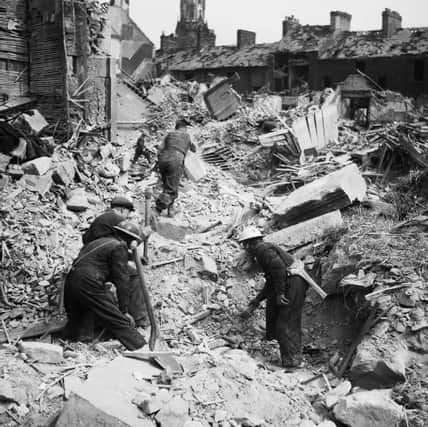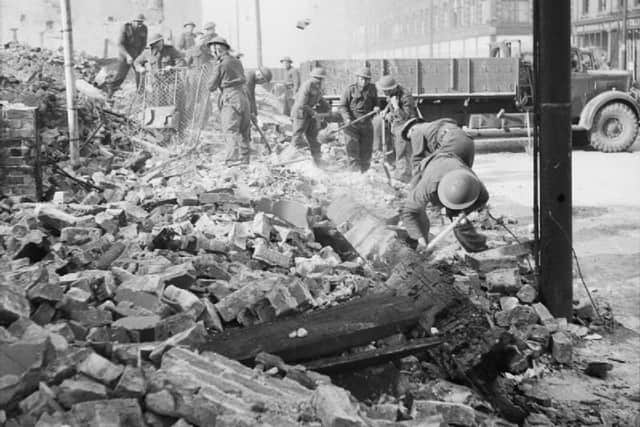Children of Belfast Blitz frolicked in deluge of fine silver sand during war


Four dates over the next two months mark the 80th anniversary of the four Luftwaffe air-raid attacks on the city in 1941.
A copy of the Ordnance Survey map used by the German bomber-crews during the attacks was reproduced here on Wednesday, along with several official Government booklets outlining a wide range of air raid precautions, and how to deal with fires and incendiaries.
Advertisement
Hide AdAdvertisement
Hide AdThere are many printed and recorded accounts of the Luftwaffe attacks on Belfast, including heart-breaking images of people searching frantically for their loved-ones in the rubble.


These, and much more, feature in a variety of forthcoming on-line and streamed anniversary events and exhibition, and in many small, private commemorations.
The Northern Ireland War Memorial Museum (niwarmemorial.org) hosts a permanent exhibition about WWII and the Easter blitz and along with a number of other local organisations is organising a special ‘Blitz 80’ series of on-line events and exhibitions.
Around 1,000 died in the raids on the city in April and May 1941, mostly in the five-hour Easter Tuesday blitz on 15/16 April and the three-hour raid on 4/5 May.
Advertisement
Hide AdAdvertisement
Hide AdThe Ordnance Survey map used by Luftwaffe’s aircrews that was reproduced here on Wednesday, with its German notes, details and annotations, is a gruesomely historic document. Stormont was referred to as Parlamentsgebäude und Ministerien; today’s George Best airport was the Zivilflugplatz; Short’s aircraft works was the Flugzeugfabrik, and the shipyard was the Werft von Harland and Wolff.
Ostseite Belfast referred to East Belfast an area hugely devastated in the attack.
The terrible tally of death, injury and destruction is foremost in the minds of those who remember the blitz, or those who’ve heard accounts passed down through the generations, but punctuating the sadness of bereavement and the terror that Belfast folk experienced were moments of ‘light relief.’
There’s the wonderful story about a policeman who was guarding a secure, open-air enclosure near Werft von Harland and Wolff during the blitz. Whilst he most certainly didn’t enjoy the relentless downpour of high explosives, his constabulary duties had a happy ending.
Advertisement
Hide AdAdvertisement
Hide AdStanding in the darkness of blackout in front of a main shipyard gateway set in a long, high wall, the policeman miraculously survived an almost direct hit.
Shaken, shocked and dazed by the blast, he pulled himself from the ground where he’d fallen in a series of high, uncontrolled somersaults.
Brushing the dust and debris from his shoulders with shaking hands, he faithfully stood guard at the gate for the rest of the night.
But when darkness lifted and daylight dawned, he discovered he’d been guarding a gate with absolutely nothing left on either side - except rubble!
Advertisement
Hide AdAdvertisement
Hide AdThe walls had been completely flattened by the bombs leaving only a badly dented gate supported by two wobbly but defiant gate posts.
Amongst the many books, websites and archived-collections about the blitz, ‘In the Shadow of the Gantries’ was written by the late and prolific local historian Noel Kirpatrick. The book is packed with colourful reminiscences by the former shipyard worker, with many poignant pages devoted to the blitz.
Almost every street had red-brick air-raid shelters with thick, reinforced concrete roofs.
The author’s description of people watching a land-mine dropping from a Luftwaffe bomber is grippingly fearsome.
Advertisement
Hide AdAdvertisement
Hide AdAs locals grimly gazed skywards - the device descended slowly, silently, swinging from side to side beneath its parachute - onto an East Belfast road junction where it blew a 20-foot crater across the whole width of roadway. With a deafening roar the road-surface became airborne. Tram lines were hurled high over the disintegrating houses, landing bent and twisted several streets away.
The heavy iron tram-way points remained attached to their lines, impaled upright in smouldering piles of debris, framed by toppled walls and dislocated lamp posts.
The terrible explosion - just one of many - revealed a curious geological secret.
Local children who clambered into the crater the next day encountered a strange, natural phenomenon - a shimmering, powdery ‘waterfall’.
Advertisement
Hide AdAdvertisement
Hide AdNoel Kirpatrick was one of the youngsters in the crater. He recounted in his book that their “footprints were soon smoothed over by the continuous pouring of fine silver sand similar to that found inside an hour glass or egg timer.”
The youngsters scooped the sand into paper bags and brought it home to their parents, who undoubtedly had other things on their minds!
Soon the workmen arrived to repair the road and the sand was covered up again.
If you’re traversing the junction between Albertbridge and Mountpottinger today, there’s a silvery labyrinth beneath, marked with happy little foot prints that all of Hitler’s devious strength couldn’t erase.
Advertisement
Hide AdAdvertisement
Hide AdThere was a tomato sauce factory in the area that escaped the full force of the bomb.
Tomato sauce was doubtlessly of less strategic value to the Luftwaffe than the nearby ship and aircraft manufacturers!
But tomatoes were scarce due to wartime shortages, and Noel Kirkpatrick recounted: “I used to watch trailer loads of turnips going into the factory from time to time and tomato sauce coming out!”
There were no Brexit hold-ups in those days - Ministry Food Inspectors were busy making vital provisions available to the community and had no time to ketchup with the bureaucrats’ legalistic intricacies!
A message from the Editor:
Advertisement
Hide AdAdvertisement
Hide AdThank you for reading this story on our website. While I have your attention, I also have an important request to make of you.
In order for us to continue to provide high quality and trusted local news on this free-to-read site, I am asking you to also please purchase a copy of our newspaper whenever you are able to do so.
Our journalists are highly trained and our content is independently regulated by IPSO to some of the most rigorous standards in the world. But being your eyes and ears comes at a price. So we need your support more than ever to buy our newspapers during this crisis.
With the coronavirus lockdown having a major impact on many of our local valued advertisers - and consequently the advertising that we receive - we are more reliant than ever on you helping us to provide you with news and information by buying a copy of our newspaper when you can safely.
Advertisement
Hide AdAdvertisement
Hide AdYou can also enjoy unlimited access to the best news from across Northern Ireland and the UK by subscribing to newsletter.co.uk
With a digital subscription, you can read more than five articles, see fewer ads, enjoy faster load times, and get access to exclusive newsletters and content. Visit https://www.newsletter.co.uk/subscriptions now to sign up.
Thank you